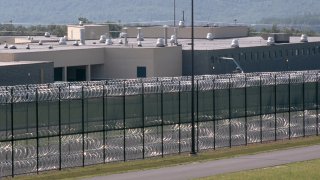
Inmates in Pennsylvania state prisons will be counted in their home districts and not where their prisons are located after a divided vote Tuesday by the five-member panel redrawing legislative district maps this year.
The Pennsylvania Legislative Reapportionment Commission voted 3-2 for the policy change that was introduced by House Minority Leader Joanna McClinton, D-Philadelphia.
“We cannot wait another 10 years. The time to correct this injustice is now,” she said.
The vote changes the longstanding policy of counting inmates toward state House and Senate districts where their state prisons are located.
Get Philly local news, weather forecasts, sports and entertainment stories to your inbox. Sign up for NBC Philadelphia newsletters.
The House and Senate Republican leaders voted no, while McClinton was joined by the Senate Democratic floor leader and by the commission's chair, former University of Pittsburgh Chancellor Mark Nordenberg.
Nordenberg, appointed by the Democratic-majority state Supreme Court as the commission’s swing vote, said that for months he “did not think I would be where I am today" but had kept an open mind.
“When a system holds and counts a person in one place but forces him or her to vote in another, it does create a basic issue of fairness,” he said.
Local
Breaking news and the stories that matter to your neighborhood.
He said counting inmates in their prison’s legislative districts “distorts the reapportionment process by giving certain classes of voters — in this case voters living in districts with state correctional institutions — votes that carry more weight than the votes cast in districts that do not include such institutions."
The commission is using 2020 Census data to redraw the state's 203 House and 50 Senate districts for use starting with next year's elections.
The proposal would cover most of the roughly 37,000 state inmates that are scattered among 23 facilities in 19 counties. Many of the prisons are located in largely white, rural areas, while their inmate populations are much more racially diverse.
The change does not affect how federal and county prisoners are counted, leaving what Senate Majority Leader Kim Ward of Westmoreland County described as a lack of uniformity.
Ward said the result will be “a big mess. And we’re going to end up in court."
The latest figures from the Corrections Department indicate that by far the most common home county for state prison inmates is Philadelphia, with more than 9,000 prisoners, or about one in four. Allegheny County, which includes Pittsburgh, accounts for more than 2,500 state prison inmates.
Inmates who were homeless before being locked up would be counted where they had most recently regularly stayed or regularly received services.
At least 1,000 inmates each are from some of the larger Pennsylvania counties — Berks, Dauphin, Delaware, Lancaster, Lehigh, Montgomery and York.
It would not apply to about 60 state prisoners who had been living in other states when they became incarcerated or to those serving life sentences. The Republican leaders also pointed out that others in group quarters, including college students and those in care facilities, will be counted as the census counted them, away from their home districts.



